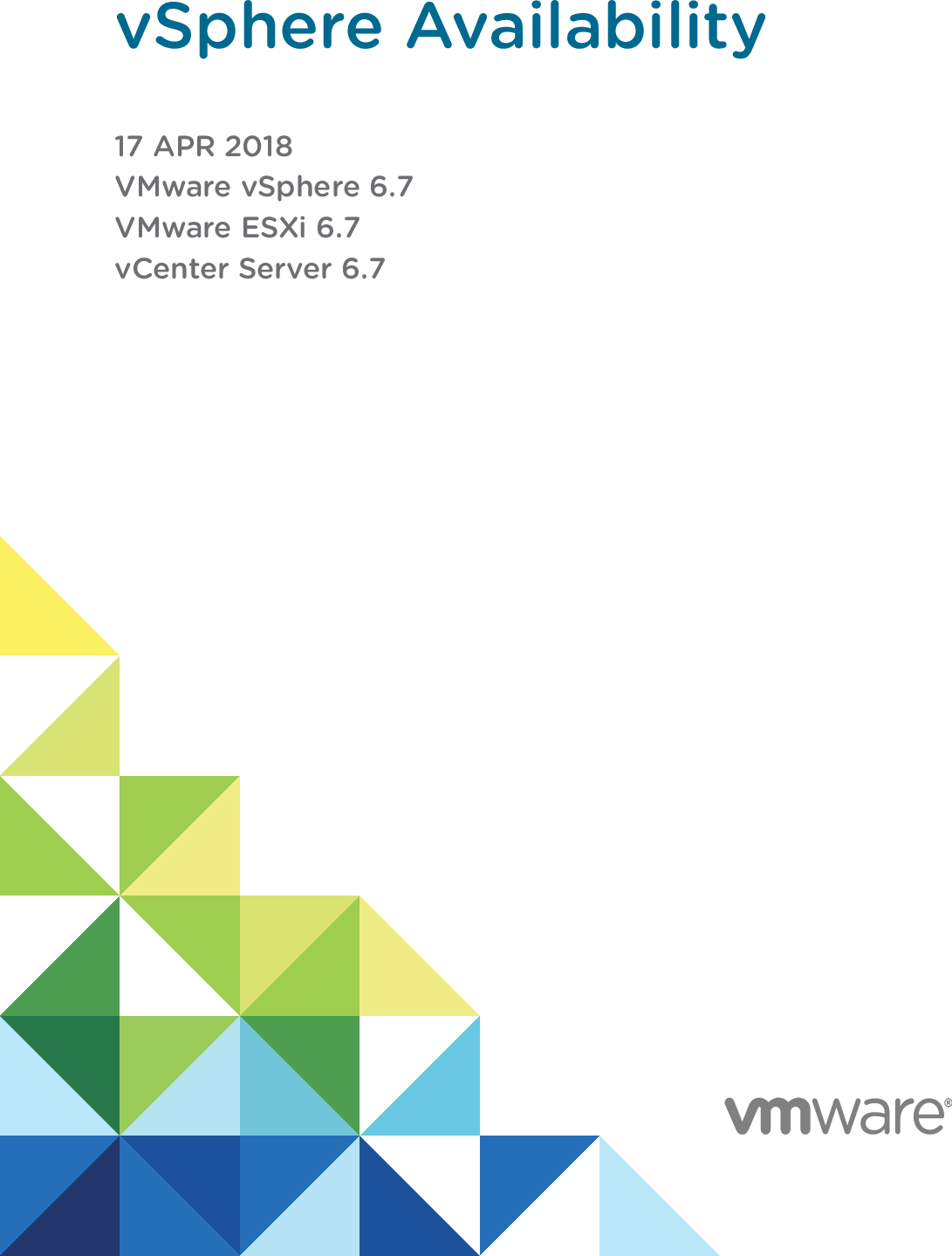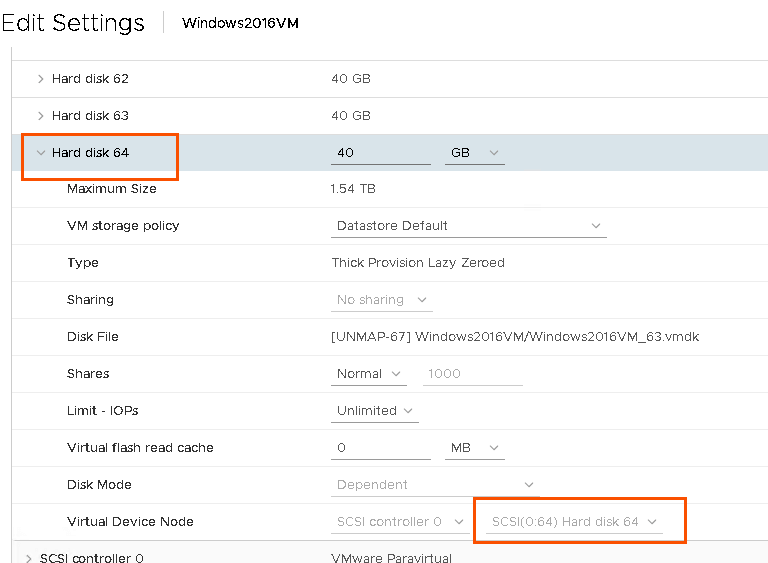This book, Performance Best Practices for VMware vSphere 6.5, provides performance tips that cover the most performance-critical areas of VMware vSphere ® 6.5. It is not intended as a comprehensive guide for planning and configuring your deployments. VMware has announced the VMware vSphere 6.5 at the end of last year. VSphere 6.5 includes some of new features & new improvements compared to current version of vSphere 6. With launch of vSphere 6.5 VMware also announced the newer version of vCenter Server Appliance 6.5. VCenter Server Appliance 6.5 provides simplified & user friendly.
What is VMware HA Slots ?
- Target audience: IT Administrators and Solution Architects planning to leverage HPE 3PAR StoreServ Storage within a VMware vSphere 6.5 environment. This white paper is based on testing performed in March 2017 with HPE 3PAR OS 3.3.1 and VMware vSphere 6.5.
- Slot size is an important concept because it affects admission control. A VMware ESXi cluster needs a way to determine how many resources need to be available in the event of a host failure. This slot calculation gives the cluster a way to reserve the right amount of resources.
/cdn.vox-cdn.com/uploads/chorus_image/image/60675421/twarren_iphonesim_1.1533038365.jpg)


'VMware HA slots is a logical representation of the memory and CPU resources that satisfy the requirements for any powered-on virtual machine in the cluster.'
If you have configured reservations at VM level, It influence the HA slot calculation. Highest memory reservation and highest CPU reservation of the VM in your cluster determines the slot size for the cluster.
Here is the Example,
If you have the VM configured with the highest memory reservation of 8192 MB (8 GB) and highest CPU reservation of 4096 MHZ. among the other VM's in the cluster, then the slot size for memory is 8192 MB and slot size for CPU is 4096 MHZ. in the cluster.
If no VM level reservation is configured , Minimum CPU size of 256 MHZ and memory size of 0 MB + VM memory overhead will be considered as CPU and Memory slot size.
Calculation for Number of HA Slots in cluster :-

Once we got the Slot size for memory and CPU by the above method , Use the below calculation
Num of CPU Slots = Total available CPU resource of ESX or cluster / CPU Slot Size
Num of memory slots = Total available memory resource of ESX or cluster minus memory used for service console & ESX system / Memory Slot size
Vsphere 6.5 Slot Size Chart
Let's take a Example,
I have 3 host on the cluster and 6 Virtual machine is running on the cluster and Each host capacity as follows
RAM = 50 GB per Host
CPU = 8 X 2.666 GHZ per host
Cluster RAM Resources = 50 X 3 = 150 GB – Memory for service console and system = 143 GB
Cluster CPU resources = 8 X 2.6 X 3 = 63 GHZ (63000 MHZ) of total CPU capacity in the cluster – CPU Capacity used by the ESX System = 60384 MHZ
I don't have any memory or CPU reservation in my cluster, So, the default CPU slot size 256 MHZ and one of my Virtual machine is assigned with 8 vcpu and its memory overhead is 344.98 MB (which is the highest overhead among my 6 virtual machines in the cluster)
Let's calculate the num of CPU & Memory slots
Num of CPU Slots = Total available CPU resource of cluster / CPUSlot size in MHZ
No of CPU Slots = 60384 MHZ / 256 MHZ = 235.875 Approx
Num of Memory Slots = Total available Memory resource of cluster / memory Slot Size in MB
Num of Memory Slots = 146432 / 345 = 424 Approx
The most restrictive number among CPU and Memory slots determines the amount of slots for this cluster. We have 235 slots available for CPU and 424 Slots available for Memory. So the most restrictive number is 235.
So, Total number of slots for my cluster is 235 Approx. Please find the below snapshot
Please refer my blog post on Understanding Total Slots, Used Slots & Available slots in VMware HA Slot to understand Total Slots, Used Slots & Available slots. I hope this article is helpful to you to understand HA slots calculation. Thanks for Reading!!. Be social and share it in social media, if you feel worth sharing it.
When vSphere 6.5 was announced I was quite impressed about the features. Gathering more and more hands-on experience so far I am more than happy with it.
One of the new features that can have a real operational benefit hasn't been documented so far that often (or at least I haven't seen it anywhere).
Before vSphere 6.5 it was impossible to increase the VMDK size of a DISK that was larger than 2TB when the Virtual Machine was powered on. That was a fact that not many organizations were aware of it until they stumbled upon it.
From an architectural point of view there shouldn't be many use cases where such a large disk layout would be the best practice. But from an operational point of view for many of my customers this has been a bigger issue.
The good thing is: With vSphere 6.5 this is not the case anymore. Important: Hardware Version 13 (vHW 13) is not required for this to work – therefore just the vSphere platform and not the VM has to be upgraded.
Increasing a hard disk from 2.4 to 3TB will just work while the VM is powered on.
Voila. The disk can be used within with the fully size without any service interruption. Quite cool isn't it?
Vsphere 6.5 Ha Slot Size
Another quite useful enhancement within vSphere 6.5 is the fact that we can now see details about the hardware customization within the events. While in the pre vSphere 6.5 era we were only able to see that a configuration of the VM took place we see now more details about this VM configuration task.

'VMware HA slots is a logical representation of the memory and CPU resources that satisfy the requirements for any powered-on virtual machine in the cluster.'
If you have configured reservations at VM level, It influence the HA slot calculation. Highest memory reservation and highest CPU reservation of the VM in your cluster determines the slot size for the cluster.
Here is the Example,
If you have the VM configured with the highest memory reservation of 8192 MB (8 GB) and highest CPU reservation of 4096 MHZ. among the other VM's in the cluster, then the slot size for memory is 8192 MB and slot size for CPU is 4096 MHZ. in the cluster.
If no VM level reservation is configured , Minimum CPU size of 256 MHZ and memory size of 0 MB + VM memory overhead will be considered as CPU and Memory slot size.
Calculation for Number of HA Slots in cluster :-
Once we got the Slot size for memory and CPU by the above method , Use the below calculation
Num of CPU Slots = Total available CPU resource of ESX or cluster / CPU Slot Size
Num of memory slots = Total available memory resource of ESX or cluster minus memory used for service console & ESX system / Memory Slot size
Vsphere 6.5 Slot Size Chart
Let's take a Example,
I have 3 host on the cluster and 6 Virtual machine is running on the cluster and Each host capacity as follows
RAM = 50 GB per Host
CPU = 8 X 2.666 GHZ per host
Cluster RAM Resources = 50 X 3 = 150 GB – Memory for service console and system = 143 GB
Cluster CPU resources = 8 X 2.6 X 3 = 63 GHZ (63000 MHZ) of total CPU capacity in the cluster – CPU Capacity used by the ESX System = 60384 MHZ
I don't have any memory or CPU reservation in my cluster, So, the default CPU slot size 256 MHZ and one of my Virtual machine is assigned with 8 vcpu and its memory overhead is 344.98 MB (which is the highest overhead among my 6 virtual machines in the cluster)
Let's calculate the num of CPU & Memory slots
Num of CPU Slots = Total available CPU resource of cluster / CPUSlot size in MHZ
No of CPU Slots = 60384 MHZ / 256 MHZ = 235.875 Approx
Num of Memory Slots = Total available Memory resource of cluster / memory Slot Size in MB
Num of Memory Slots = 146432 / 345 = 424 Approx
The most restrictive number among CPU and Memory slots determines the amount of slots for this cluster. We have 235 slots available for CPU and 424 Slots available for Memory. So the most restrictive number is 235.
So, Total number of slots for my cluster is 235 Approx. Please find the below snapshot
Please refer my blog post on Understanding Total Slots, Used Slots & Available slots in VMware HA Slot to understand Total Slots, Used Slots & Available slots. I hope this article is helpful to you to understand HA slots calculation. Thanks for Reading!!. Be social and share it in social media, if you feel worth sharing it.
When vSphere 6.5 was announced I was quite impressed about the features. Gathering more and more hands-on experience so far I am more than happy with it.
One of the new features that can have a real operational benefit hasn't been documented so far that often (or at least I haven't seen it anywhere).
Before vSphere 6.5 it was impossible to increase the VMDK size of a DISK that was larger than 2TB when the Virtual Machine was powered on. That was a fact that not many organizations were aware of it until they stumbled upon it.
From an architectural point of view there shouldn't be many use cases where such a large disk layout would be the best practice. But from an operational point of view for many of my customers this has been a bigger issue.
The good thing is: With vSphere 6.5 this is not the case anymore. Important: Hardware Version 13 (vHW 13) is not required for this to work – therefore just the vSphere platform and not the VM has to be upgraded.
Increasing a hard disk from 2.4 to 3TB will just work while the VM is powered on.
Voila. The disk can be used within with the fully size without any service interruption. Quite cool isn't it?
Vsphere 6.5 Ha Slot Size
Another quite useful enhancement within vSphere 6.5 is the fact that we can now see details about the hardware customization within the events. While in the pre vSphere 6.5 era we were only able to see that a configuration of the VM took place we see now more details about this VM configuration task.
Just select reconfiguration event in Host & Clusters or VMs & Templates: VM -> Monitor -> Events
The first bigger vSphere 6.5 update must be around the corner. So I would recommend you to plan the upgrade. Check out my blog post about the general design considerations and tasks to be done before upgrading the vCenter.